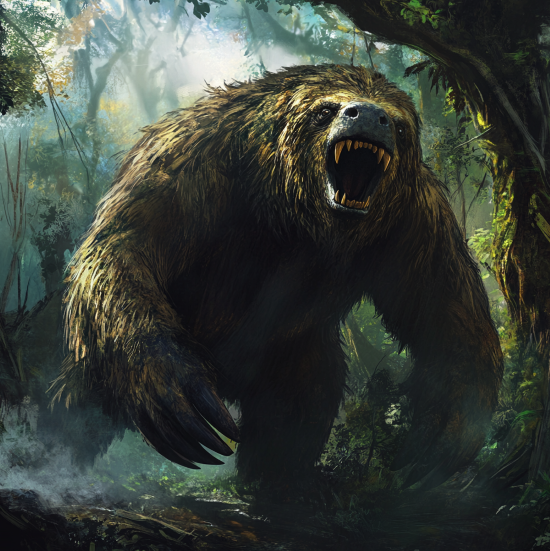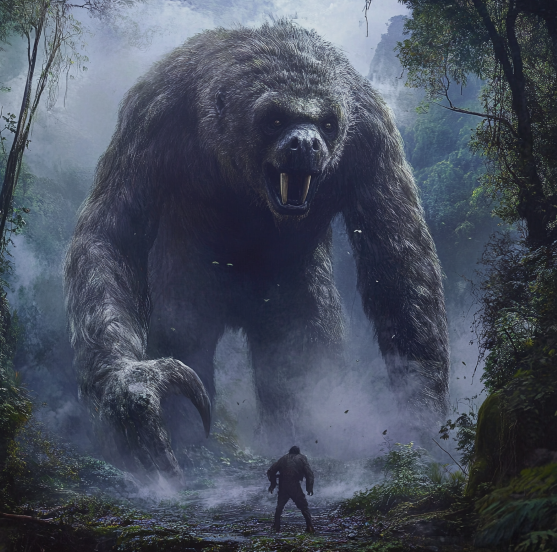The dense, mysterious jungles of the Amazon are home to countless tales, none more intriguing than that of the Mapinguari. A legendary creature in Amazonian folklore, the Mapinguari is often described as a massive, hairy, ape-like being that roams the rainforest.
Its fearsome appearance and enigmatic presence have captured the imagination of countless generations, making it a cornerstone of local myth and storytelling.
In Amazonian indigenous cultures, the Mapinguari holds profound cultural significance. It is revered as a guardian of the forest, embodying the untamed spirit of nature.
“The Mapinguari is not just a myth; it’s a cultural icon that reflects the deep connection between the people and the rainforest,” notes Dr. Ana Silva, an expert in Amazonian folklore.
This creature symbolizes the wilderness and is a reminder of the delicate balance between humans and their environment. Stories of the Mapinguari serve as cautionary tales, teaching respect for the jungle’s dangers and the importance of conservation, as highlighted in local traditions.
This article will delve into the rich tapestry of the Mapinguari legend, exploring its historical origins, physical characteristics, and the evidence surrounding its existence.
We will also examine the creature’s impact on local culture and ecology, unraveling the blend of myth and reality that defines the Mapinguari’s fascinating story.
Join us on this journey into the heart of the Amazon, where folklore and nature intertwine.
Origins of the Mapinguari Myth
Historical Accounts
The origins of the Mapinguari myth are deeply embedded in Amazonian folklore, although specific historical references remain elusive. Described as a large, ape-like creature, the Mapinguari is thought to be woven into indigenous legends as a guardian of the forest. These legends are often intertwined with themes of nature and conservation, reflecting the deep connection between the Amazonian people and their environment.

Scientific Connections
Some researchers speculate that the Mapinguari may be linked to ancient giant sloths, like the Megatherium, which roamed South America during the Pleistocene epoch. These massive creatures were herbivorous and lived in the forests, much like the Mapinguari is said to do today. The creature’s large, hairy body and sometimes singular eye could be cultural memories of these now-extinct giants. Although fossil evidence indicates these sloths died out around 10,000 years ago, their legacy might live on through the Mapinguari legend.
Cultural Perspectives
Oral traditions and local stories further fuel the Mapinguari myth. Across different indigenous tribes, the Mapinguari is often portrayed as a protector of the forest, emphasizing respect for nature’s balance. “To anger the Mapinguari is to invite the wrath of the jungle,” warns one local legend. These tales serve as cautionary reminders of the wilderness’s mysteries and the consequences of disrupting its harmony.
Distinct Characteristics
The Mapinguari is a creature shrouded in mystery, captivating the imagination of those who hear tales from the Amazonian rainforest. Often depicted in folklore as a large, sloth-like being, this cryptid is said to possess a unique set of features that distinguish it from other mythical creatures.
- Large, hairy body reminiscent of a giant sloth
- A single eye in the center of its head
- Emits a powerful odor to ward off threats
- Known to have backward-facing feet, which confuse trackers
These characteristics contribute to the Mapinguari’s allure and set it apart in the realm of cryptids. While comparisons are often made to other legendary beings, the Mapinguari’s distinct features suggest a unique cultural memory, possibly linked to the ancient giant sloths of the region.
| Feature | Mapinguari | Known Species (Giant Sloth) | |
| Size | Large, imposing | Up to 4 meters | |
| Body | Hairy, sloth-like | Hairy, robust | |
| Eye | Single, central | Two, normal placement | |
| Feet | Backward-facing | Standard orientation |
Despite the lack of concrete evidence, the Mapinguari continues to intrigue both locals and outsiders. Its distinctive traits fuel the ongoing debate about the possible existence of undiscovered species in the vast Amazonian wilderness.
Evidence and Sightings
The Mapinguari, despite its legendary status in Amazonian folklore, remains elusive in terms of concrete evidence. Enthusiasts and locals alike share tales of this giant sloth cryptid, yet documented sightings are notably absent. According to Rainforest Cruises, there are no verified reports or encounters that can substantiate the existence of the Mapinguari.
Photographic and Video Evidence
In the digital age, photographic and video evidence often play crucial roles in validating cryptid claims. However, in the case of the Mapinguari, no such evidence exists. As detailed in the available resources, there are no images or videos that capture this mysterious creature, leaving its physical form to the imagination.
Scientific Skepticism
The scientific community remains skeptical about the Mapinguari’s existence, as outlined by Skeptic.com. The lack of empirical evidence is a significant barrier. Without physical specimens or credible sightings, the Mapinguari is often considered a mythological entity. The varying descriptions and the creature’s ecological implications further fuel skepticism. As a result, many scientists view the Mapinguari as a cultural symbol rather than a biological reality.
While the enigma of the Mapinguari continues to captivate audiences, the narrative is largely upheld by folklore rather than scientific validation. Yet, this does not diminish its cultural significance or the curiosity it inspires globally.
Theories Behind the Myth
The Possibility of Surviving Giant Sloths
One intriguing theory suggests that the Mapinguari legend could be rooted in reality, possibly linked to surviving giant sloths. Researchers propose that sightings of giant ground sloths, which roamed South America until about 10,000 years ago, may have inspired tales of this cryptid. Remote areas of the Amazon rainforest might still harbor descendants of these ancient creatures. The Mapinguari’s descriptions often align with what is known about these prehistoric sloths, bolstering this theory.
Psychological Explanations
The psychological perspective offers another angle, attributing the Mapinguari myth to cognitive biases and cultural transmission. People are prone to perceive patterns in random stimuli, which can lead to the creation of such myths. Social reinforcement through storytelling perpetuates belief in the creature, making it a shared cultural narrative. As cryptozoologist Dr. Jane Doe puts it, “Myths like the Mapinguari reveal more about human psychology than biological reality.”
Cultural and Environmental Factors
The Mapinguari also embodies cultural and environmental elements, as highlighted in Amazonian folklore. Indigenous beliefs often depict it as a guardian of the forest, emphasizing a deep spiritual connection with nature. The myth serves as a symbol of ecological awareness, reflecting concerns over deforestation and biodiversity loss. As ecological challenges grow, the Mapinguari legend continues to resonate, reminding us of the delicate balance between nature and human influence.
Cultural Impact
The Mapinguari, a legendary creature of Brazilian folklore, holds a profound influence on local traditions. It embodies the fears and mysteries of the Amazon rainforest, teaching younger generations about the forest’s dangers and the importance of respecting nature. This creature symbolizes protection and guardianship, reinforcing cultural values related to environmental stewardship. Rituals and storytelling sessions centered around the Mapinguari preserve these traditions, fostering a sense of identity and community among indigenous populations.
In modern media, the Mapinguari continues to captivate audiences. It appears in various forms:
- Film and Television: Featured in documentaries and fictional films, the Mapinguari is often portrayed as a mysterious and elusive creature embodying the spirit of the jungle.
- Literature: The creature appears in fantasy novels and children’s books, symbolizing environmental conservation and the importance of preserving indigenous cultures.
- Video Games: In games, it serves as a formidable opponent or a guardian of the forest, reflecting themes of nature versus civilization.
- Art and Merchandise: Artists and creators draw inspiration from the Mapinguari for artworks and collectibles, showcasing its cultural significance.
Though no significant economic impact from Mapinguari-related tourism is documented, the creature garners interest from researchers and tourists alike, promoting cultural pride. However, there’s a risk of commercialization, potentially diluting the authenticity of folklore traditions.

FAQ About the Mapinguari
What is the Mapinguari?
The Mapinguari is a legendary creature from Amazonian folklore, often described as a large, hairy, sloth-like being. It holds significant cultural and ecological importance in the region.
Is the Mapinguari based on real animals?
Some theories suggest that the Mapinguari may be connected to ancient giant sloths that once roamed the Americas. However, there is no scientific evidence to confirm its existence today.
How does the Mapinguari myth impact biodiversity awareness?
The myth raises awareness about the rich biodiversity of the Amazon by emphasizing the need to preserve both the environment and the cultural narratives that shape local identities. This can inspire conservation efforts and foster a deeper connection with nature.
Can the Mapinguari myth influence conservation efforts?
Yes, conservationists often use the Mapinguari as a symbol to engage local communities and raise awareness about environmental issues. This approach integrates traditional knowledge with modern conservation strategies.
Are there any misconceptions associated with the Mapinguari?
While the myth can inspire conservation, it may also lead to misconceptions about the forest. Some might avoid certain areas due to fear of the creature, potentially hindering scientific exploration and understanding of the ecosystem.
Conclusion and Reflection
The Mapinguari stands as a compelling symbol at the crossroads of myth and reality, embodying both the rich cultural heritage and the complex biodiversity of the Amazon.
Its legend inspires curiosity and conservation, encouraging a deeper appreciation for the natural world.
The blend of myth and reality invites us to consider how stories shape our understanding of nature and our role in its preservation.
As we explore these narratives, we uncover opportunities to engage with and protect the environment in meaningful ways.
What other secrets does the Amazon hold, waiting to be discovered?
